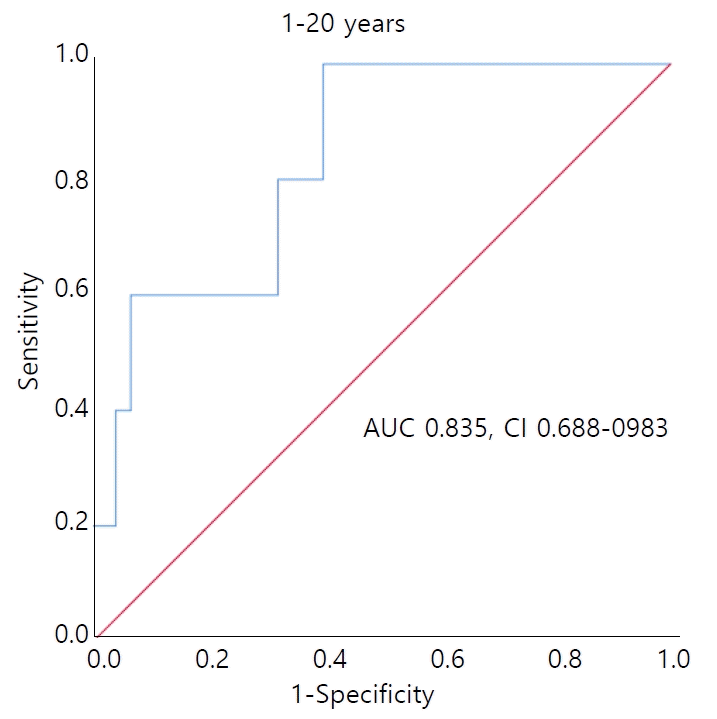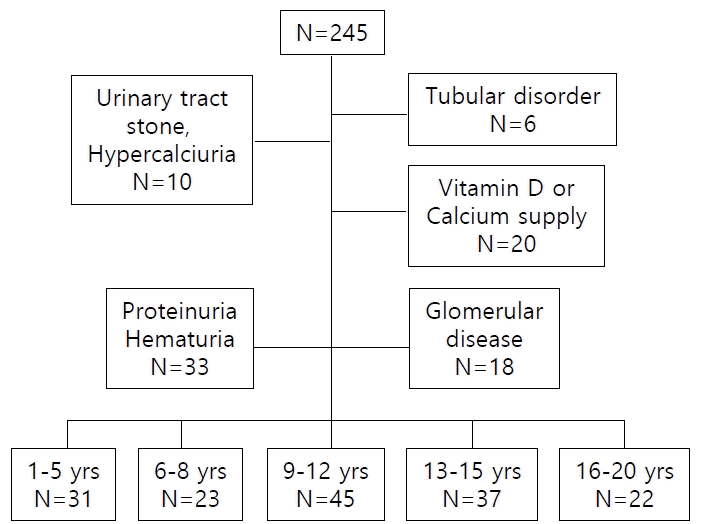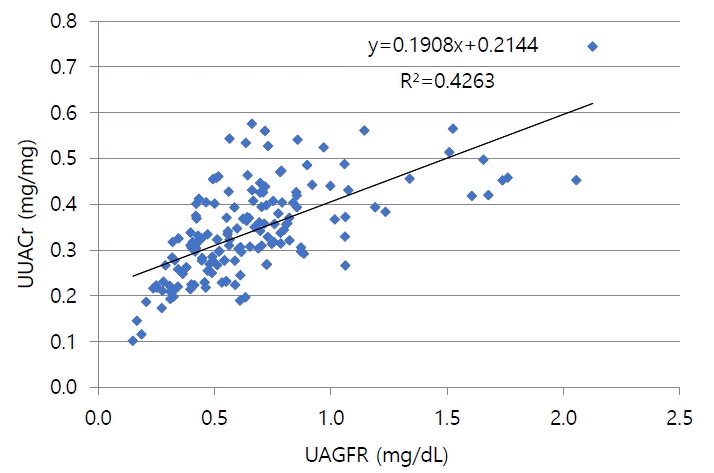1. Arrabal-Polo MA, Cano-Garcia MDC, Arrabal-Martin M. Lithogenic activity as a factor to consider in the metabolic evaluation of patients with calcium lithiasis. Iran J Kidney Dis. 2015; 9:469–7.
2. Cillo AC, Cattini H, Boim MA, Schor N. Evaluation of lithogenic elements in urine of healthy newborns. Pediatr Nephrol. 2001; 16:1080–3.

3. Hartung R. The significance of uric acid in calcium oxalate nephrolithiasis. MMW. 1975; 117:387–90.
4. La Manna A, Polito C, Marte A, Iovene A, Di Toro R. Hyperuricosuria in children: clinical presentation and natural history. Pediatrics. 2001; 107:86–90.

5. Hodgkinson A. Uric acid disorders in patients with calcium stones. Br J Urol. 1976; 48:1–5.
6. Stapleton FB. Hematuria associated with hypercalciuria and hyperuricosuria: a practical approach. Pediatr Nephrol. 1994; 8:756–61.

7. Stapleton FB, Linshaw MA, Hassanein K, Gruskin AB. Uric acid excretion in normal children. J Pediatr. 1978; 92:911–4.

8. Stapleton FB, Nash DA. A screening test for hyperuricosuria. J Pediatr. 1983; 102:88–90.

9. Chen YH, Lee AJ, Chen CH, Chesney RW, Stapleton FB, Roy S. Urinary mineral excretion among normal Taiwanese children. Pediatr Nephrol. 1994; 8:36–9.

10. Safarinejad MR. Urinary mineral excretion in healthy Iranian children. Pediatr Nephrol. 2003; 18:140–4.

11. Kompani F, Gaedi Z, Ahmadzadeh A, Seyedzadeh A, Bahadoram M. Values of urinary mineral excretion in healthy Iranian. J Ped Nephrol. 2015; 3:26–30.
12. Marco RH, Gómez FN, Costa CM, Moreno JF, Vidal AP, Solanes JB. Excreción urinaria de calcio, magnesio, ácido úrico y ácido oxálico en niños normales [Urinary excretion of calcium, magnesium, uric acid and oxalic acid in normal children]. An Esp Pediatr. 1988; 29:99–104.
13. Matos V, Van Melle G, Werner D, Bardy D, Guignard JP. Urinary oxalate and urate to creatinine ratios in a healthy pediatric population. Am J Kidney Dis. 1999; 34:e1.

14. Öner A, Erdogan Ö, Çamurdanoglu D, Demircin G, Bülbül M, Delibas A. Reference values for urinary calcium and uric acid excretion in healthy Turkish children. Int Pediatr. 2004; 19:154–7.
15. Poyrazoğlu HM, Düşünsel R, Yazici C, Durmaz H, Dursun I, Şahin H, et al. Urinary uric acid : Creatinine ratios in healthy Turkish children. Pediatr Int. 2009; 51:526–9.

16. Sweid HA, Bagga A, Vaswani M, Vasudev V, Ahuja RK, Srivastava RN. Urinary excretion of minerals, oxalate, and uric acid in north Indian children. Pediatr Nephrol. 1997; 11:189–92.

17. Moriwaki Y, Yamamoto T, Takahashi S, Yamakita J, Tsutsumi Z, Hada T. Spot urine uric acid to creatinine ratio used in the estimation of uric acid excretion in primary gout. J Rheumatol. 2001; 28:1306–10.
18. Williams K, Thomson D, Seto I, Contopoulos-Ioannidis DG, Ioannidis JP, Curtis S, et al. Standard 6: age groups for pediatric trials. Pediatrics. 2012; 129:S153–60.

19. Baldree LA, Stapleton FB. Uric Acid Metabolism in Children. Pediatr Clin North Am. 1990; 37:391–418.

20. Mantani N, Hoshino A, Ito K, Kogure T, Moridaira K, Sakamoto H, et al. Relationships among urine pH, serum uric acid and pyuria in hospitalized elderly patients. Nihon Ronen Igakkai Zasshi. 2004; 41:542–555.

21. Grivna M, Průsa R, Janda J. Urinary uric acid excretion in healthy male infants. Pediatr Nephrol. 1997; 11:623–4.

22. Penido MG, Diniz JS, Guimarães MM, Cardoso RB, Souto MF, Penido MG. Urinary excretion of calcium, uric acid and citrate in healthy children and adolescents. J Pediatr (Rio J). 2002; 78:153–60.

23. Hasday JD. Noctural increase of urinary uric acid:creatinine ratio. A biochemical correlate of sleep-associated hypoxemia. Am Rev Respir Dis. 1987; 134:534–8.
24. Kaufman JM, Greene ML, Seegmiller JE. Urine uric acid to creatinine ratio-a screening test for inherited disorders of purine metabolism. Phosphoribosyltransferase (PRT) deficiency in X-linked cerebral palsy and in a variant of gout. J Pediatr. 1968; 73:583–92.
25. Zöllner N. Influence of various purines on uric acid metabolism. Bibl Nutr Dieta. 1973; 34:43.

26. Daniel CR, Cross AJ, Koebnick C, Sinha R. Trends in meat consumption in the USA. Public Health Nutr. 2011; 14:575–83.

27. Welfare MoHa. The Korean Nutrition Society. Dietary reference intakes for Koreans 2020. In : . Sejong: 2020.





 PDF
PDF Citation
Citation Print
Print





 XML Download
XML Download